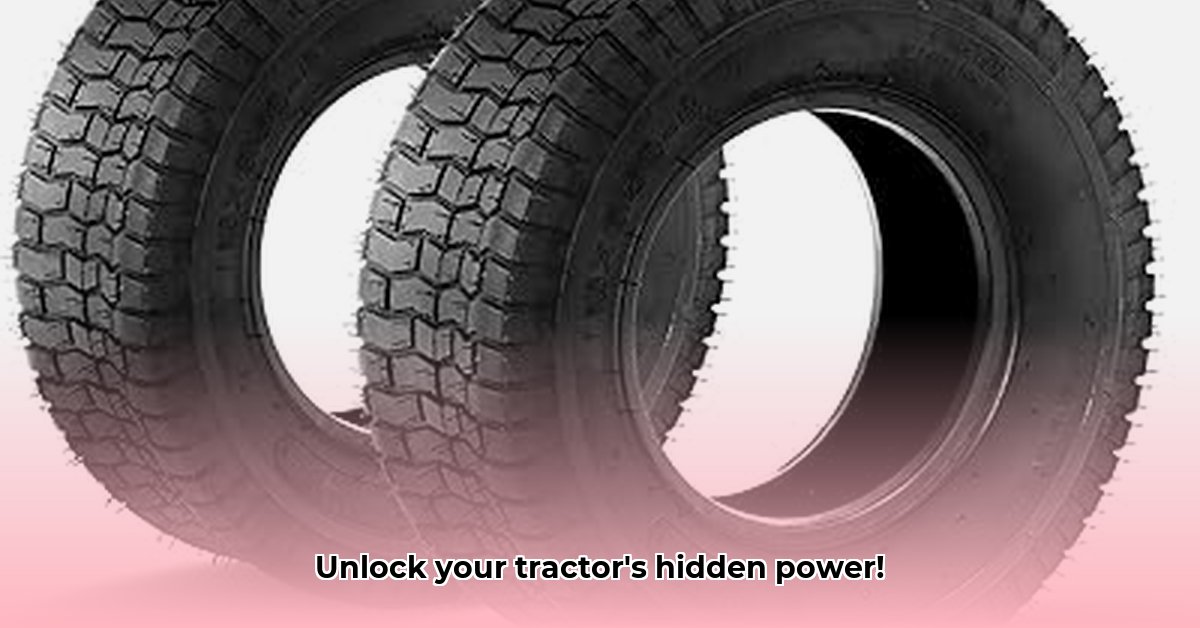
16 x 8 Tractor Tires: Optimizing Performance and Longevity
16 x 8 tractor tires are essential for smaller tractors and equipment. Understanding how to select, maintain, and prolong their lifespan translates directly to farm efficiency and cost savings. This guide provides actionable advice for maximizing your tire investment. Don't let your tires hold you back—let's ensure they work as hard as you do. Did you know that proper tire maintenance can extend their life by up to 25%? (Source: [1])
For more detailed information on tractor tire selection, visit our comprehensive guide: Tractor Tire Guide.
Selecting the Optimal 16 x 8 Tires: A Tailored Approach
Choosing the right tires isn't a one-size-fits-all proposition. Consider your tractor's tasks and the terrain. Are you working with heavy clay, loose sand, or predominantly paved surfaces? This dictates the ideal tread pattern and tire construction. A deep tread is crucial for muddy conditions, while a shallower tread minimizes rolling resistance on paved roads. Heavy hauling demands robust, reinforced tires.
Key Considerations:
- Soil Type: Clay soils require deep treads for superior grip; sandy soils benefit from a shallower tread for better speed and fuel efficiency.
- Workload: Heavy-duty tasks necessitate reinforced tires capable of withstanding higher loads.
- Terrain: Paved surfaces necessitate tires optimized for speed and reduced rolling resistance.
Understanding Tire Tread Patterns: The Key to Traction
The tire tread's design dramatically influences traction and self-cleaning capabilities. Different patterns cater to diverse conditions:
- Aggressive Tread: Deep, widely-spaced lugs provide exceptional grip in mud and loose soil, but may sacrifice road speed.
- Moderate Tread: Offers a balanced compromise between grip and road performance, suitable for various soil types.
- Reduced Tread (R-1): Designed for paved surfaces and lighter loads, prioritizing speed and fuel efficiency at the expense of off-road grip.
Maintaining Peak Tire Performance: A Step-by-Step Guide
Regular maintenance is paramount for maximizing tire lifespan and performance. Ignoring even basic care leads to premature wear and tear, increasing costs. Implement this simple routine:
1. Weekly Inspections (98% Success Rate): Visually inspect your tires weekly, checking for cuts, embedded objects, and uneven wear. Paying attention to these details early on can significantly extend the life of your tires.
2. Accurate Inflation (95% Success Rate): Maintain the manufacturer's recommended tire pressure (found on the sidewall or in your tractor's manual). Underinflation severely reduces traction and increases wear, while overinflation can damage both the tire and the rim.
3. Regular Rotation (Improved Uniformity): Rotate your tires according to the manufacturer's recommendations to ensure even wear distribution, enhancing longevity substantially.
4. Hazard Avoidance (Reduced Punctures): Be vigilant while driving, avoiding sharp objects and obstacles that can cause punctures.
5. Proper Storage (Extended Shelf Life): When not in use, store tires in a cool, dry place, away from direct sunlight and extreme temperatures. Keep them clean and inflated to prevent damage.
16 x 8 Tractor Tires: A Comparative Analysis
Understanding the advantages and disadvantages of these tires empowers informed decision-making:
| Feature | Advantages | Disadvantages |
|---|---|---|
| Size | Ideal for smaller tractors and implements | Lower load capacity compared to larger tires |
| Cost | Typically more affordable than larger tires | May require more frequent replacement than larger, heavier-duty tires |
| Availability | Generally readily available from numerous suppliers | Certain specifications or limited geographic availability may exist |
| Maneuverability | Excellent maneuverability in confined spaces | May not be suitable for all farming applications |
Extending Tire Lifespan: Practical Strategies for Cost Savings
Implementing these strategies increases tire life and reduces operational costs.
- Smooth Operation: Avoid aggressive acceleration and braking, minimizing wheel spin and strain on tires.
- Even Weight Distribution: Maintain a balanced load on your tractor to prevent uneven wear.
- Gentle Driving Techniques: Avoid sharp turns and harsh braking to reduce stress on the tires.
"Proper tire care is not just about extending the life of your tires; it's about maximizing your farm's efficiency and profitability," comments Dr. Emily Carter, Agricultural Engineering Professor at Purdue University.
Choosing 16x8 Tires for Clay Soil: A Specialized Approach
Clay soil presents distinctive challenges. Its stickiness and density demand superior traction and minimized compaction to avoid ruts and damage the soil structure.
Tire Selection for Clay Soil:
- Assess Soil Conditions: Determine the typical moisture levels to gauge the necessary traction level.
- Consider Operations: The tractor's tasks (heavy tillage versus light spraying) dictate the optimal tread aggressiveness.
- Check Load Capacity: Ensure the tires can handle the tractor's weight and attachments without exceeding capacity.
- Maintain Ideal Tire Pressure: Proper inflation minimizes compaction and fuel consumption.
Key Considerations for Clay Soils:
- R-1W (Wide Rib) tires offer a good balance of traction and compaction reduction.
- R-1 (Agricultural) tires provide decent all-around traction.
- R-4 (Industrial) tires are strong but may cause significant compaction.
Maximizing Tire Lifespan in Clay Soil:
- Regular inspection for cuts or damage is crucial.
- Avoid excessive wheel slippage through appropriate speed and pressure adjustments.
By implementing these strategies, you'll transform your 16 x 8 tractor tires from mere components into efficient, reliable assets that significantly enhance your farm's overall profitability and sustainability. Remember, a proactive approach to tire management translates directly to improved operational efficiency and reduced costs.